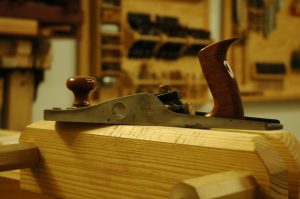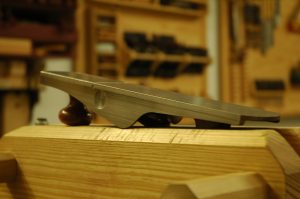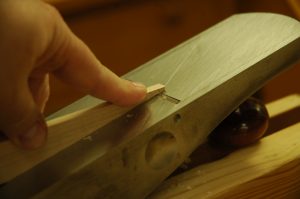We may receive a commission when you use our affiliate links. However, this does not impact our recommendations.


 We have these adages in the woodworking world: Hand-tool woodworkers prefer taking the tool to the wood, power-tool users prefer taking the wood to the tool; Westerners operate on the push, Easterners on the pull. I’m here to say we need an adage for a technique I’ve been finding extremely useful. Let’s call it the Australian way: Using tools upside down.
We have these adages in the woodworking world: Hand-tool woodworkers prefer taking the tool to the wood, power-tool users prefer taking the wood to the tool; Westerners operate on the push, Easterners on the pull. I’m here to say we need an adage for a technique I’ve been finding extremely useful. Let’s call it the Australian way: Using tools upside down.
These past weeks I’ve been making lots of small parts in batches – the kinds of things that if, using tools the “proper” hand-tool way (clamping them up so we can securely take the tool to the wood), would have taken an inordinate amount of time. But because of an upside-down technique I was able to batch them out quickly, with greater control and more accuracy. It also showed me another reason why I so love my low-angle jack plane.
Coopers use a giant jointing plane by turning it upside down and leaning it against the wall. I took that idea and clamped my jack plane into a vise upside down. This enabled me to hold the piece of wood and control its passage over the blade.
Now this may sound scary, but you soon realize it’s no more dangerous than shaving or testing the depth of blade. You are running your hand at 90° to the blade so if you accidentally touch, it’ll just glide over. Plus, you’re not using that much pressure or speeding across. I do suggest not skewing because, well… that would skin ya. But being able to pick up a small un-clampable piece, quickly plane it smooth and to the proper angle, then put it down and pick up another, is just an easy way to work. I could see this technique being commonplace in things like marquetry where you are sometimes jointing small boards (veneer). Just hold ’em together and plane ’em straight.
This works exceptionally well with modern low-angle jacks because the handle can drop into the clamp and the knob can rest on the bench. Quick and easy clamping that also provides an efficient ramp. You could do the same thing with a traditional Bailey-style plane, but because of the frog and high angle of the blade, it would mean squeezing the sides which could deform the plane a little or even break it because they used non-malleable steel. Modern low-angle planes definitely have the advantage here.
Sawing small parts using the “Australian Way” is also quick and easy. How many times have you needed to cut a bunch of plugs? Most of the time the actual size isn’t that important because you’ll flush-trim them later. You just need the plugs. This would be dangerous on a chop saw or table saw because your hands would be too close to the blade. But drop your backsaw into the vise upside down, place your hands on each side using your knuckles as a fence, then hold the dowel or blank in your hands and slide down. Quick and easy. (I was once told this was the technique that inspired Bridge City Tool Works’ Jointmaker.)
The Upside Down and Backward method of woodworking: great for working small fine parts. What other tools can be used “The Australian Way”?
Here are some supplies and tools we find essential in our everyday work around the shop. We may receive a commission from sales referred by our links; however, we have carefully selected these products for their usefulness and quality.









This method also works quite well when I made the wedges for my hollows and rounds. Clamping the plane once and making a skim cut a few times and checking the fit of the wedge after each cut was easier then clamping the wedge several times and using a low angle block plane each time. Just be aware of the location of your fingers to avoid a manicure.
Similarly, the block plane is the consummate pencil sharpener for carpenters pencils. Held upside down in one hand and the pencil in the other, which moves back and forth across the blade at the appropriate low angle. Nice.
I learned this technique decades ago as a youth making wooden railroaded models from scratch. Alas, I used a low-angle block plane taped to,my workbench. When I graduated into full scale woodworking, I brought this technique with me. It is very useful in forming pieces for repair/restoration.ł
I’m making this contribution with all due respect to Graham. This comment is not about him, it is about woodworking magazines in general. It seems.any useful technique will be published even if it has been in use since prehistoric times. I appreciate the thought, but please resist telling us such things as how to cut a plug flush with a Japanese saw and sandpaper. Leave that Get Started in Woodworkinhg or Woodworkers. Journal. But if somebody figures ou a new way of doing something or creative jig or fixture, the I am all for it
Upside down in more ways than one ???????
As I look at the photo (#3) the knob is top right and elevated away from you so the cutting edge would be facing top right – you would have to be pulling the wood down toward you rather than the more familiar way of pushing it over the cutting edge???? Or did someone forget to check when staging the photo?
Hmmm… Australia is upside down? Say it ain’t so. Is there such a thing as a hemispherist or hemisphobic? We Aussies tend to think all you northern hemispherites have this upside down caper all back to front! (lol)
Yep, do this with small bits that are difficult to clamp on the bench but easy to hold in the hand. Clamp the plane (careful about where and how hard you clamp, don’t snap the wings!) upside-down and away you go.
Works very well to match-plane two small bits you want to join, say like two rays of a veneer starburst.
I’ll use a plane upside down to fit small components like pegs or wedges. I also recently made some small door pulls and dialed in their size and shape with this method. Some parts are just too small to hold any way but between your fingers! Three cheers for the Aussie method.